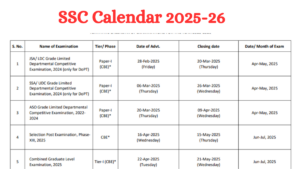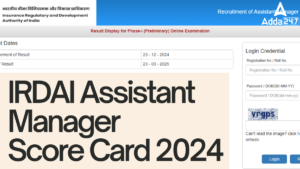Quantitative Aptitude Quiz For SBI PO/Clerk Prelims
Q1. A train covers 3584 km in 2 days 8 hours. If it covers 1440 km on the first day and 1608 km on the second day, by how much does the average speed of the train for the remaining part of the journey differ from that for the entire journey?
Avg. speed for entire journey = 3584/56 = 64 km/hr
ATQ
Remaining distance (3584 – 1440 – 1608) = 536 km has to be covered in 8 hrs.
∴ speed of remaining journey = 536/8 = 67 kmph
Difference = 3 kmph more
Q2. The average age of A and B is 22 years. If C were to replace A, the average would be 18 and if C were to replace B, the average would be 23. What are the ages of A, B and C?
⇒ A + B = 44
and B + C = 36
and C + A = 46
∴ A + B + C = 126/2 = 63
∴ Age of A = 63 – 36 = 27 years
Age of B = 63 – 46 = 17 years
Age of C = 63 – 44 = 19 years
Q3. If 1 is added to the age of the elder sister, then the ratio of the ages of two sisters becomes 0.5 : 1, but if 2 is subtracted from the age of the younger one, the ratio becomes 1 : 3. Find the age of the two sisters.
Q4. If the ages of P and R are added to twice the age of Q, the total becomes 59. If the ages of Q and R are added to thrice the age of P, the total becomes 68 and if the age of P is added to thrice the age of Q and thrice the age of R, the total becomes 108. What is the age of P?
Q + R + 3P = 68 …………(ii)
P + 3Q + 3R = 108 ………….(iii)
From 3 × (ii) – (iii)
P = 12 years
Q5. The average age of a class is 40 years. 12 new students with an average age of 32 years join the class, thereby decreasing the average age by 4 years. The original strength of the class was:
Q6. Sneh’s age is one-sixth of her father’s age. Sneh’s father’s age will be twice of Vimal’s age after 10 years. If Vimal’s eighth birthday was celebrated 2 years before, then what is Sneh’s present age?
Given,
S = F/6
F + 10 = 2(V + 10)
And
V – 2 = 8
∴ V = 10 years
F = 2 (10 + 10) – 10 = 30 years.
So, Sneh’s present age = 5 years
Q7. The average income of a person for the first 6 days is Rs. 29, for the next 6 days it is Rs. 24, for the next 10 days it is Rs. 32 and for the remaining days of the month it is Rs. 30. Find the average income per day (Assume month is of 30 days).
Q8. A man covers half of his journey by train at 60 km/hr, half of the remainder by bus at 30 km/hr and the rest by cycle at 10 km/hr. Find his average speed during the entire journey.
Q9. There are 5 consecutive odd numbers. If the difference between square of the average of first two odd number and the square of the average of last two odd numbers is 492, what is the smallest odd number?
ATQ,
(x + 3) ² – (x – 3) ² = 492
⇒ 12x = 492
⇒ x = 41
∴ smallest odd no. = 41 – 4 = 37
Q10. With an average speed of 40 km/hr, a train reaches its destination in time. If it goes with an average speed of 35 km/hr, it is late by 15 minutes. The length of the total journey is
Directions (11-15): In each of the following questions two equations are given. Solve the equations and give answer—
Q11. I. y² + 2y – 3 = 0
II. 2x² – 7x + 6 = 0
y² +3y – y – 3 = 0
(y + 3) (y- 1) = 0
y = -3 or 1
II. 2x² -7x + 6 = 0
2x² – 4x -3x + 6 = 0
2x(x – 2) – 3 (x- 2) = 0
(x – 2) (2x – 3) = 0
x = 2 or 3/2
x > y
Q12. I. (x)² = 961
II. y =√961
x = ± 31
II. y = √961 =31
y ≥ x
Q13. I. 15x² – 19x + 6 = 0
II. 45y² – 47y + 12 = 0
15x² – 9x – 10x + 6 = 0
3x (5x – 3) -2 (5x – 3) = 0
(5x- 3) (3x- 2) = 0
x = 3/5 or 2/3
II. 45y² – 47y + 12 = 0
45y² – 20y – 27y + 12= 0
5y (9y – 4) – 3 (9y – 4) = 0
(9y – 4) (5y – 3) = 0
y = 4/9 or 3/5
x ≥ y
Q14. I. 2x² + 5x + 2 = 0
II. 12y² + 7y + 1 = 0
2x² + 4x + x + 2 = 0
2x (x + 2) +1 (x+ 2) = 0
x = -2 or -1/2
II. 12y² + 7y + 1 = 0
12y² + 4y+ 3y+ 1 = 0
4y(3y + 1) + 1 (3y+ 1) = 0
(3y + 1) (4y+ 1) = 0
y = -1/3 or -1/4
y > x
Q15. I. 2x² – 13x + 21 = 0
II. 5y² – 22y + 21 = 0
2x² – 7x – 6x + 21 = 0
x(2x – 7) – 3 (2x – 7) = 0
(2x – 7) (x – 3) = 0
x=7/2 or 3
II. 5y² – 22y + 21 = 0
5y² – 15y – 7y + 21 = 0
5y(y- 3) – 7 (y- 3) = 0
(y – 3) (5y – 7) = 0
y=3 or 7/5
x≥y






 The Hindu Review October 2022: Download ...
The Hindu Review October 2022: Download ...
 SSC Calendar 2025-26 Out, Check SSC CGL,...
SSC Calendar 2025-26 Out, Check SSC CGL,...
 IRDAI Assistant Manager Score Card 2024 ...
IRDAI Assistant Manager Score Card 2024 ...




